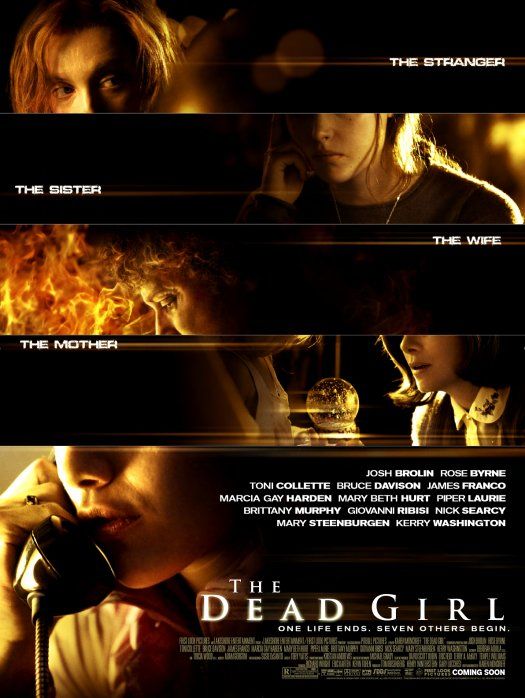(2007, directed by Karen Moncrieff, 85 min., U.S.)
BY DAN BUSKIRK FILM CRITIC
This past week I happened to see Rosanna Arquette’s 2002 film Searching For Debra Winger, a star-filled documentary in which a wide array of film actresses talk about the joys and heartaches of being a woman in the business. Marcia Gay Harden is among the actresses rightfully bemoaning the dearth of juicy roles for women, and a film like Karen Moncrieff‘s The Dead Girl, an anthology film with roles for eight actresses (includingt Harden), is just the sort of worthy project these women were imagining.Following five troubled dames whose lives are changed by the discovery of a young women’s corpse, The Dead Girl allows a number of resourceful actresses to take center stage their moment of melodrama. Unfortunately, they’re then stranded with trite, TV-style writing. “Indie” at one time hinted at fresh stories and perspectives; with The Dead Girl “indie” is just another set of reflexes, as tired and tread-worn as a bad TV cop show.
Ten or 15 years ago many forgettable U.S. indie films were often built around young couples hashing over their relationships at parties and in quirky city apartments (think Eric Stolz and Ione Skye). Since the success of multi-character dramas like Magnolia and 21 Grams, the indie world has cranked out an endless cycle of interwoven, multi-character stories peppered with drugs, sexual abuse and crime, all the better to underline the serious intent of their authors. The Dead Girl is a textbook example, its five stories separated with title cards like “The Stranger” and “The Mother,” giving each character a little more than 15 minutes to dabble in some nasty situation, then portray some revelatory moment. Watch them stew in their juices! Toni Collette plays the morose, sexually repressed stranger who finds the body; Harden plays the corpse’s mother; a shockingly matronly Mary Beth Hurt (Garp’s wife) the wife of the suspected killer, and newcomer Rose Byrne plays a woman who believes the corpse is her long-disappeared sister. It’s studying these actresses that the sustains your attention as the The Dead Girl unspools, and their solid craft and occasional transcendence supply the film’s best moments. The film’s glum tone gives The Dead Girl the false impression that it is a serious film, one that is struggling to illuminate some findable truth about its somber subject matter. It’s here that Karen Moncrieff’s superficial script trips up its performers. The film is stuck in a worldview recognizable only through TV, a world where a person’s motivations are simplified to a single telling event and life unfolds in perfectly-timed emotional climaxes. That’s fine if you’re looking for to escape into cinematic fantasies, but with The Dead Girl, Moncrieff is actually just titillating us with all this sex and murder but doesn’t really want to wrestle with anything untidy.
Only in the final chapter, where Brittany Murphy embodies the final days of the dead girl does the film seem to loosen up and enjoy its seedy terrain. Skinny and raccoon-eyed, Murphy basically plays her prostitute hellion like Courtney Love in her ’90’s glory, a barbed-wire ball of raspy-throated curses, scratching, punching and whiny pleading. Her brief moment of victory, riding a motorcycle through L.A., screaming and bleeding from the nose after sucker-punching a jerky guy, is an elated thrill which reminds you what a preachy and dour drag the rest of the film has been. I love leaving a film bummed out by seeing someone’s truthful and sad moment of clarity, but why sit through a downer like The Dead Girl when all its weeping and grief is just high soap opera drained of all the trashy fun makes the genre redeemable in the first place? The answer is why ask why. Next, please.
